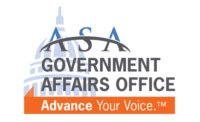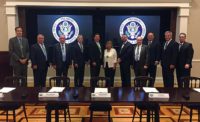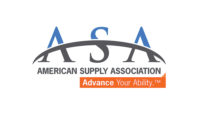ASA-led coalition asks White House to support labor-shortage efforts

According to a study by the American Supply Association (ASA), roughly 200,000 people are currently employed in the manufacturing and distribution segments of the plumbing, heating, cooling and piping (PHCP) and pipe, valves and fittings (PVF) industry. In addition, the U.S. Department of Labor’s Bureau of Labor Statistics estimates 400,000 installers are now employed. Thus, the plumbing industry is a significant source of high-paying professional jobs.
Unfortunately, industry experts predict the industry will lose 25% of its current labor force in the next 18 years and nearly half by 2035. But shortages are already having significant impact on the delivery and installation of industry products in both the plumbing and industrial PVF markets. Distributors are reporting that product earmarked for a project sits on warehouse shelves because of backlog from contractors. And representatives from the contractor sector report contractors are declining new work due to current lack of labor availability. Authoritative studies predict this labor shortage will escalate construction prices and hinder the availability of dependable services to Americans who need system repairs and renovations. A barrier to meeting the demand of a shrinking labor force is that after graduating high school, many students who enter formal Bureau of Apprenticeship (BAT) programs fail to complete the four-year curriculum.
Changing how we train
The plumbing industry currently operates about 300-500 apprenticeship programs that offer various degrees of training. But this is not nearly enough to keep pace with the demand from those leaving through retirement. This is not lost on
President Trump and administration officials who are all too familiar with
contractor-looming labor shortages. Solutions lie in industry partnerships
with the federal government to create more innovative training programs that will attract young job seekers to the industry and get them on jobsites faster. These new programs will need to look beyond the traditional four-year USDOL Bureau of Apprenticeship Training programs that can be slow and bureaucratic.
Speed training and attracting new labor
The plumbing industry believes that a “jump-start” approach is needed that allows students to get through their training faster in order to contribute sooner toward servicing our nation’s water systems. These programs should be flexible to the way today’s students want to learn and not so reliant on older systems because “that’s the way we have always trained our apprentices.”
Long-term solutions lie in reinstituting pre-apprenticeship classes in our nation’s high schools that will not only expose the next generation of workers to the rewarding careers that are available to them but get them through a four-year program faster.
Nothing will solve our generational labor crisis in construction and the pipe trades more effectively than exposing hundreds-of-thousands of students to these careers by taking classes while they are in high school. Most importantly, we strongly urge that graduates from these accredited high school classes be recognized by the Department of Labor’s BAT as second- or third-year apprentices, thus propelling them through their post-high school curriculum and getting them on the job and earning as journeymen at a faster pace.
On June 15, President Trump signed EO 13801, “Expanding Apprenticeships in America,” The Department of Labor’s Task Force on Apprenticeship Expansion will be co-chaired by Secretary of Labor Acosta and Secretary of Education DeVos and will include 20 representatives from a broad cross-section of business. To date, more than 400 applications have been submitted for consideration. We note that the task force’s report must specifically address the following four topics:
- Federal initiatives to promote apprenticeships;
- Administrative and legislative reforms that would facilitate the formation and success of apprenticeship programs;
- The most effective strategies for creating industry-recognized apprenticeships; and
- The most effective strategies for amplifying and encouraging private-sector initiatives to promote apprenticeships.
The plumbing industry has a plan
Led by the American Supply Association and Plumbing-Heating-Cooling Contractors Association, the PHCP & PVF industry is unified in its support to “jump-start” apprenticeship programs that begin with high school pre-apprenticeship classes. On Sept. 14, 12 industry CEOs from both the ASA and PHCC met with senior staff at the White House to discuss the looming issue as well as potential long-term solutions. During the 70-minute give-and-take meeting, the industry representatives presented what we plan to do to begin tackling this problem:
Led by a joint effort from ASA and PHCC, the industry will work with high school districts throughout the nation to establish 1000 pre-apprentice applied technology classes in the pipe trades by the year 2020 that will be accredited programs which will offer students full-time jobs out of high school (career alternatives to college).
- Industry will provide each program with a quality instructor and all materials such as toilets, faucets, valves, pipes, tools, etc., to conduct the classes and support lab work.
- Assistance in creating a one- and two-year curriculum and support providing educational materials will include delivery of education in formats that facilitate students’ learning.
- Support in finding employment after graduation in order to continue their mastering of the craft and building a life-long career of employment.
- Doubling the number of active apprenticeship programs offered by 2020 to ensure that students seeking to complete their training can gain the necessary training.
But recognizing that industry alone can’t solve this program, we asked the president to support our efforts with the following actions:
Summary of industry input to the president’s EO 13801
- “Jump-start” four-year apprenticeship programs through DOL recognition for accredited high school applied-technology training so that students in a one- or two-year applied-technology plumbing program are recognized as second- or third-year apprentices getting them as full journeymen faster.
- Department of Education support in urging the nation’s high schools to mirror the Palatine (Ill.) Township High School District 211 Construction Applied Technology Program and support industry efforts to start these high school options.
- Urge the National Governors Association to set a priority of getting construction classes back into the nation’s high schools.
- Create a national plumbing license superseding state licenses that stresses uniformity. One national license will simplify training as well as lowering costs for these employees and businesses that work cross-jurisdictions. It will also assist worker portability to seek jobs where they are available.
The Final Ask: rebuilding America’s infrastructure
The plumbing, heating, cooling, pipe, valve and fittings industry has a long history of protecting the nation’s health through the delivery of clean drinking water, fuel, natural gas and the safe removal of waste. This is predicated on quality manufactured products, the reliable delivery of those products, and highly trained mechanics to install the systems that provide our nation with dependable and invaluable resources.
We have seen the results from ignoring an infrastructure not readily visible to the public in tragedies such as Flint, Mich. Those in the industry know that most of America’s major cities have old, deteriorating water and gas infrastructures loaded with lead, crumbling pipes and aging valves long ignored because they are not in plain sight like our roads and bridges.
We impressed upon the president the urgency to include plumbing and PVF in the infrastructure investment. For these and many other reasons, it’s imperative that we attract, train and retain the labor force that will provide vital services for future generations of Americans.
Looking for a reprint of this article?
From high-res PDFs to custom plaques, order your copy today!





